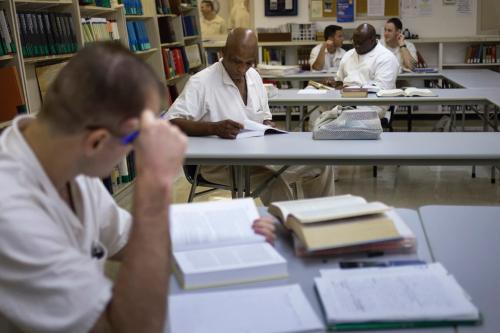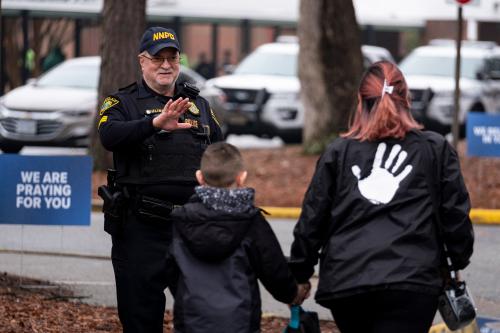It is hard to overstate the benefits of providing postsecondary education to incarcerated students. The incarcerated population has lower average education levels than the general population, which, coupled with the stigma of a criminal record, makes it difficult for returning citizens to find jobs—especially if they are Black. Individuals who enroll in postsecondary education programs are 48% less likely to be reincarcerated than those who do not, and the odds of being employed post-release are 12% higher for individuals who participate in any type of correctional education. Estimates suggest that for every $1 spent on correctional education, $4 to $5 are saved on reincarceration costs. Additionally, individuals who complete college courses are eligible for higher-paying jobs compared to people without a college education.
Beyond fiscal benefits and inspiring stories of transformation, postsecondary prison education programs are inextricably linked to advancing racial equity, especially given inequality in K-12 education that feeds low-income Black and Latinx students into the school-to-prison pipeline. The prison population is disproportionately comprised of people from racially segregated low-income communities. Individuals returning home from prison with college credentials play an important role in encouraging family members and friends to pursue additional education.
There are significant differences in the racial makeup of the U.S. college population compared to that of Second Chance Pell, a pilot program that funds selected college-in-prison programs. As of 2018, Black students represented 13.4% of college students and 30% of Second Chance Pell students, according to surveys of Second Chance Pell programs by the Vera Institute of Justice.
That said, relative to their share of the U.S. prison population, white students are overrepresented in Second Chance Pell prison-education programs, Black students constitute roughly the same share of both populations, and Latinx students are underrepresented. Second Chance Pell programs seem to be growing slightly more diverse as time goes on—Black students made up 34% of Second Chance Pell students in 2020, up from 30% in 2018, and white students made up 41% of Second Chance Pell students in 2020, decreasing from 50% in 2018.
The 1994 crime bill banned incarcerated college students from accessing federal Pell Grants. Many states followed suit, banning incarcerated students from using state-level tuition aid programs. For instance, New York prohibited incarcerated students from accessing its Tuition Assistance Program (TAP) in 1995. The impact was extreme and swift: Between 1995 and 1996, the number of postsecondary prison education programs in New York fell from 25 to four, and the number of incarcerated postsecondary students shrank from 3,445 to 256. Today, prison-education programs rely primarily on private donations, along with funding from the Second Chance Pell program, constraining the number of students that they can serve. Programs in New York had an average acceptance rate of only 33% in 2014, and 95% of programs surveyed indicated that they could reach more students if additional financial aid was available.
Federal and state tuition-assistance programs play vital roles in supporting postsecondary prison education programs. Incarcerated people have median incomes 41% lower that other people their ages prior to being incarcerated, and are paid extremely low wages for their work in prison, much of which is deducted or used to pay for things such as medical care and personal necessities from commissary. Sixty-four percent of people in state and federal prisons are academically qualified for postsecondary prison education programs, yet as of 2014, only 9% of incarcerated individuals completed college courses while in prison.
At the end of 2020, Congress finally restored access to Pell Grants for incarcerated students, and that new provision will go into effect by July 1, 2023. Some states are also taking steps to bolster access to college in prison. Michigan granted incarcerated students access to its TAP in 2019, and New Jersey accorded access to state financial aid in 2020, joining D.C. and 17 other states without explicit barriers preventing incarcerated students from accessing state financial-aid programs. Ruth Delaney and Juan Martinez-Hill of the Vera Institute of Justice are currently conducting research on how the federal Pell Grant restoration will impact incarcerated students’ access to state financial-aid programs. Multiple states tie eligibility for their state financial-aid programs to Pell Grant eligibility. As such, Delaney and Martinez-Hill expect that once Pell restoration takes effect, the number of states without barriers precluding incarcerated students from accessing state financial aid will increase.
Yet, numerous states continue to ban incarcerated students from accessing state financial-aid programs, including states with some of the largest prison populations in the U.S., such as New York, Georgia, and Pennsylvania. In Pennsylvania, students must be of “satisfactory character” to access the Pennsylvania State Grant Program. The Pennsylvania Higher Education Assistance Agency has deemed all incarcerated individuals to be of unsatisfactory character, a racist categorization that overlooks the capacity of all people to grow.
Restoring state financial-aid access across all states to students enrolled in postsecondary prison education programs is both fiscally responsible and a moral imperative given the long history of racial injustice in the United States. The cost of doing so would be relatively small. For example, if New York gave incarcerated students access to TAP again, it would account for less than 1% of the TAP budget, and it could save the state between $22 and $27.5 million annually on reincarceration costs.
Given the dramatic payoff of postsecondary prison education, it is clear that such programs are a powerful—and cost effective—tool for rehabilitation and renewal. There are many valuable components of criminal justice reform, but we should not ignore the benefits of education and its ability to put people back on track to meaningful opportunities.





Commentary
The societal benefits of postsecondary prison education
August 20, 2021